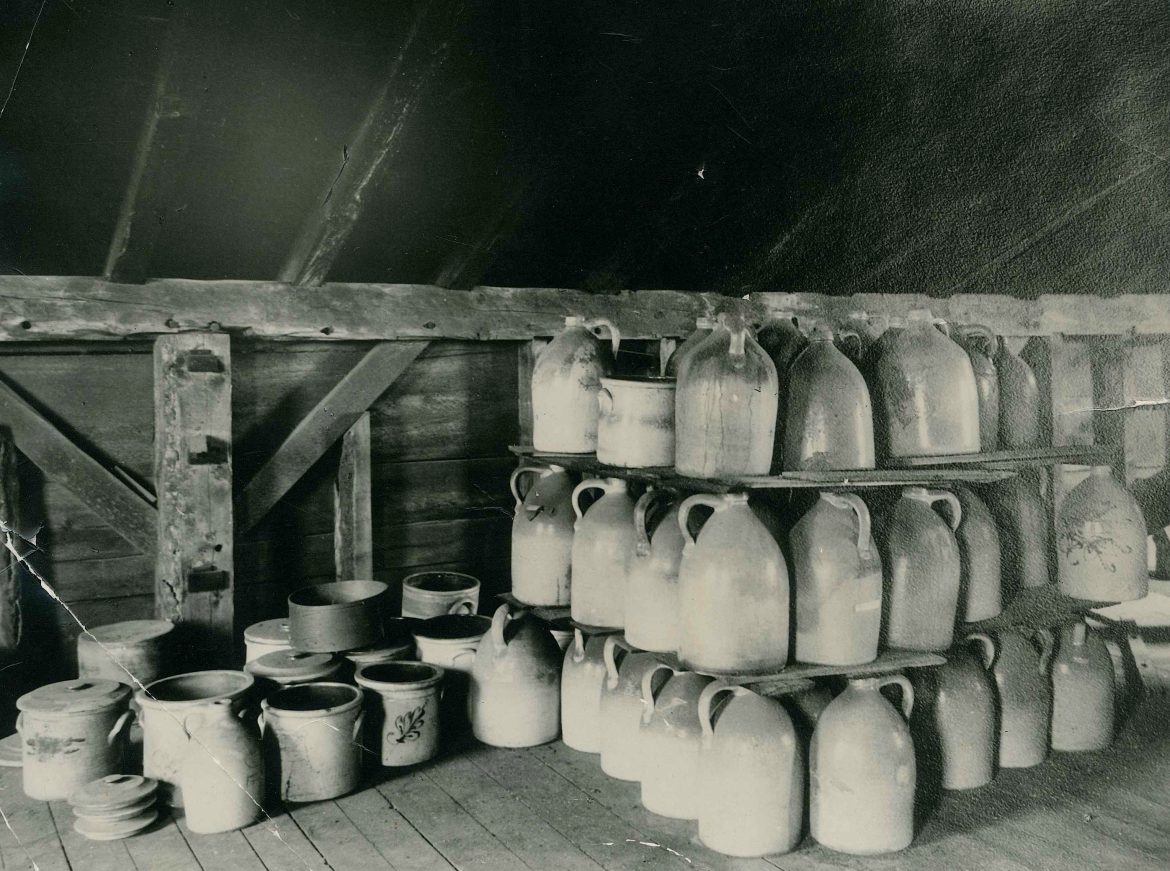
Stoneware Vessels in the Attic of a Building at Mount Lebanon, NY, ca. 1930s, Shaker Museum | Mount Lebanon: 1957.8564.1. This photograph was made as part of the New York State Art Project in the 1930s. These photographs eventually became part of the Historic American Buildings Survey.
In the fall of 2017, Coco Raymond, a student at Bard College at Simon’s Rock, interned at Shaker Museum | Mount Lebanon. Ms. Raymond’s interest in ceramics and learning about museum work made her a natural fit for a project cataloging the Museum’s collection of commercially made stoneware owned and used by the Mount Lebanon […]
In the fall of 2017, Coco Raymond, a student at Bard College at Simon’s Rock, interned at Shaker Museum | Mount Lebanon. Ms. Raymond’s interest in ceramics and learning about museum work made her a natural fit for a project cataloging the Museum’s collection of commercially made stoneware owned and used by the Mount Lebanon Shakers. Ms. Raymond wrote this blog.
The Shakers owned many ceramic vessels. At the Mount Lebanon community, stoneware jugs and crocks were generally made at local commercial potteries – and there were plenty of those in the area. The only clay products the Shakers at Mount Lebanon made themselves were smoking pipes and pipes for draining wetland. Shaker Museum | Mount Lebanon holds a collection of sixty pieces of stoneware – most of which were used at Mount Lebanon.
The Shakers had considerable need for these vessels. Jugs, holding from one to ten gallons of liquid, were used to store and sell medicinal extracts and distilled liquids such as witch hazel. Crocks were traditionally used for putting up pickles and preserving other foodstuffs. Large jugs fitted with bung holes at the bottom were used as water coolers that could be taken to the brothers working in the fields.

Stoneware Crock, Church Family, Mount Lebanon, NY, ca. 1850, Shaker Museum | Mount Lebanon: 1950.702.1. John Mulligan, photographer. This three gallon crock stored Juglans cinerea, that is, an extract from the butternut tree used as both a dyestuff for coloring cloth or as a medicine with a mild cathartic effect.
Most of the vessels in the Museum’s collection were produced between the 1840s and the 1860s. The New York stoneware industry was at its peak from 1830 to 1890. The New England ceramic industry began on a smaller scale in the late 17th century with the production of redware, a type of red stoneware commercialized in America in 1625. The golden age of New England and New York pottery was mostly in the 19th century, but lasted until 1943 when Hilfinger Pottery in Fort Edward, New York closed. The work produced in New York and New England during this period was stylistically influenced by German Pennsylvanian potters and English potters. Unlike redware, the materials used to make stoneware are not naturally occurring in New England, so New England potteries had to transport clays from New Jersey and New York. Stoneware was preferred over earthenware due to fears of poisoning from lead glazes commonly used on earthenware vessels. Almost all of the stoneware jugs owned by the Shakers feature a salt glaze, which was popular due to its resistance to acidic foods and the natural sealant the salt glaze provides.

Stoneware Jug, Church Family, Mount Lebanon, NY, 1861-1885, Shaker Museum | Mount Lebanon: 1950.714.1. John Mulligan, photographer. This jug was made by Satterlee & Mory at Fort Edward, NY. It contained Chelidonium majus, or greater celandine, a preparation used for liver diseases and general digestive problems.
Many early stoneware vessels had an inner coating of ochre, but this material fell out of use after the discovery of a material called Albany slip found in the Hudson River in the early 1800s. This rich dark brown slip was used to coat the inside of almost all of the jugs, crocks, and coolers in the Museum’s collection. The jugs are decorated with slip-trailed or slip painted cobalt motifs, most commonly in the shape of flowers, plants, or occasionally, birds. Several feature tornado-like zig-zags or spirals. Some of the designs have bubbled and chipped as an excess of cobalt slip will react with the salt glaze layered on top of it. Most of the pieces lack variation in the relatively simple shape of the vessel’s body, indicating a focus on functionality over aesthetics. The jugs are generally straight with a slight swell at the chest before the shape reduces to a narrow neck. The coolers are visually similar to the jugs with the addition of a bung at the base and much taller and thicker handles to support the vessel’s considerable weight. The crocks are less curvy, with a thick lip and two lug handles on the sides. Their lids are most often plain save for the occasional layer of Albany slip or glaze. A few feature unusually ornate reliefs of flowers or grapes, most likely from a press mold. Almost all of the pieces feature a maker’s stamp, which was pressed into the wet body with an overlay of cobalt slip.
Sources:
“American Pottery History.” n.d. Accessed December 15, 2017. http://www.corzilius.org/Narratives/PotteryInAmerica.htm.
“Antique Redware | Pottery & Porcelain Price Guide | Antiques & Collectibles Price Guide.” n.d. Accessed December 15, 2017. https://www.kovels.com/price-guide/pottery-porcelain-price-guide/redware.html.
“Exraordinary [sic] Shaker Herbalist Account Book & Diary.” n.d. M & S Rare Books. Accessed December 15, 2017. http://www.msrarebooks.com/4DCGI/w_BookDetailS/20951.
Grant, Jerry. “Jugs and Pots.” Shaker Museum | Mount Lebanon (blog). October 5, 2016. https://shakerml.wordpress.com/2016/10/05/jugs-and-pots/. Accessed December 15, 2017.
Mansberger, Floyd. “Nineteenth Century Pottery Production In Illinois.” n.d. Accessed December 15, 2017. http://illinoisarchaeology.com/ceramics/Roberts%20Volume%20Paper.pdf.
Ketchum, William C., Jr. Potters and Potteries of New York State, 1650-1900. Second edition. New York: Syracuse University Press, 1987.